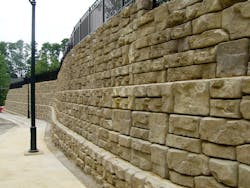Challenging access road at new FBI headquarters calls for innovative solutions
When the FBI was relocating its division headquarters near Cincinnati, the terrain at the new site included some extreme grade changes—which made for some challenging planning for an access road to the site. The new access road was slated for a tight space between an existing residential neighborhood and a major office building, which meant that construction required a 19.5-ft-high, 700-ft-long retaining wall.
After evaluating the costs and impacts of a variety of wall systems, the engineering firm URS contacted Redi-Rock to explore the potential use of its large block retaining-wall system. Following close coordination between URS, Redi-Rock, and the township, the design team determined that the retaining-wall system could meet the goals of the project better than any other system.
“Sycamore Township chose [the system] because we had a limited amount of space; we did not want to cut back behind the wall for tie-ins and we didn’t want to lose trees that were buffering the neighbors from the project,” explained Tracy Kellums, superintendent for Sycamore Township.
Dave Wormald, P.E., of URS Corp. explained further: “One of the primary reasons we chose the [retaining-wall] system was because we wanted to design a gravity wall to reduce the amount of excavation required with minimal disruption behind the wall as well as creating an aesthetically pleasing appearance.”
To reach the required 19.5 ft with a gravity wall, URS utilized several unique components of the retaining-wall system to achieve a custom solution for the project without the need for geogrid reinforcement or anchors.
First, URS specified 3,420-lb, 60-in. base blocks for the bottom six to eight courses of the wall. Just one course was buried. Then, URS specified several courses of 9-in. blocks throughout the wall to vary the batter. “We incorporated the 9-in. blocks to increase the resistance to overturning forces without the need for geogrid reinforcement,” Wormald explained.
For the higher courses in the wall where the loading was less, the blocks transitioned to 41-in. blocks and 28-in. blocks to achieve the full height of the wall. Compacted free-draining aggregate backfill and leveling pads were used.
Combining a variety of blocks allowed the wall to achieve its goal height while minimizing excavation and impacts to the trees. Plus, the gravity solution saved the township time and money on installation.
The 8,000-sq-ft wall was installed in less than three weeks. The blocks installed quickly like giant Lego blocks using a piece of heavy machinery and a small crew.
Curious how much a solution like this costs? The answer may surprise you. Click here to locate your local retailer and get a quote.
